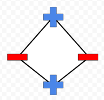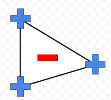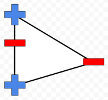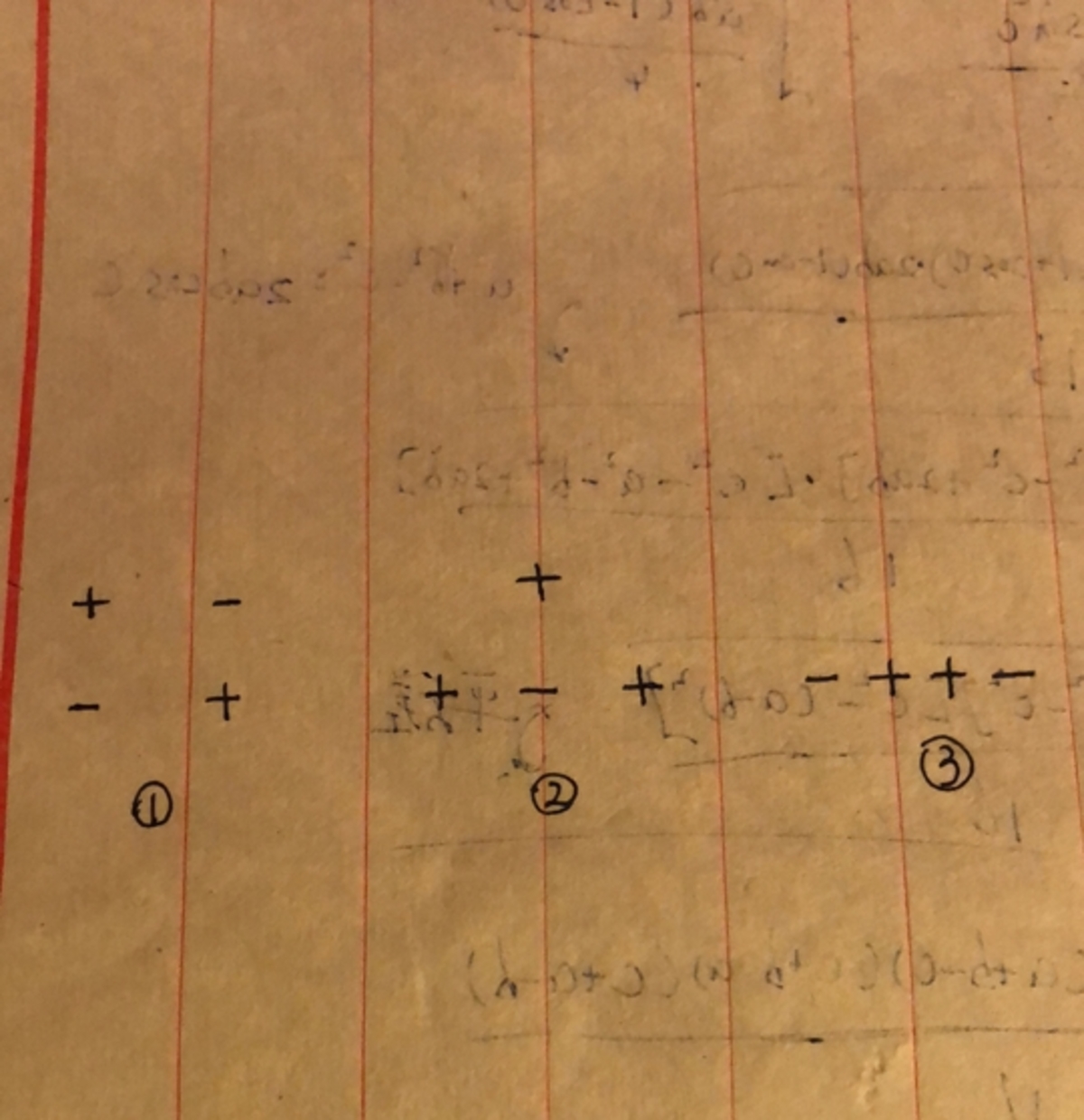Shattering Points
Krishna and Satvik are playing a game called 3-Point Shattering , which has the following rules:
- Krishna chooses where to place 3 points on a large sheet of paper.
- Satvik marks each point either blue or red.
- Krishna tries to draw a line such that all the blue points are on one side of it and all the red points are on the other.
Krishna wins if he can do Step 3. Otherwise, Satvik wins. Here are some examples of how Krishna can win:
Notice that Krishna can still win if Satvik marks all the points the same color.
However, if they played a slightly different game, 4-Point Shattering , where Krishna starts by placing 4 points, who has a winning strategy?
This section requires Javascript.
You are seeing this because something didn't load right. We suggest you, (a) try
refreshing the page, (b) enabling javascript if it is disabled on your browser and,
finally, (c)
loading the
non-javascript version of this page
. We're sorry about the hassle.
9 solutions
This is pretty cool, isn't it? These things are known as VC dimensions and one of the interesting implications this theory has is to be able to figure out whether a certain kind of datset can be classified using Support Vector Machines.
Log in to reply
Linear classification in ML was the thing that I immediately thought about, too!
I think you need to slightly modify the argument by making another case distinction in your last step: Your description only works if the four points form a convex quadrilateral. (Otherwise I also don't quite understand what you mean by "diagonally opposite"). If however three of the four points form a triangle containing the fourth, any choice of assigning two +'s and two -'s to the four points will make it possible for Krishna to win. In this case you want to mark the vertices of the triangle with one color and the point in its interior with the other, which provides Satvik with a winning strategy.
Log in to reply
I agree with this observation.
Yeah, I didn’t think about the concave quadrilateral case until you brought it up. I’ve edited my solution to include that case. Thanks!
Wait Wait your question was : "However, if they played a slightly different game, 4-Point Shattering, where Krishna starts by placing 4 points, who has a winning strategy?" Krishna starts by placing 4 points so Satvik can't draw a line then &Krishna wins! the four-point game.
Log in to reply
Satvik chooses the colors of points, Krishna drawes the line
Krishna starts by placing 4 points , Satvik assigns red/blue colour to them and then Krishna draws the line!
I just simply saw it as making sure your coloured points are opposite pairs.
Krishna always wins, because nowhere is stated there must be a straight line.
Log in to reply
By definition, all lines are straight. If the problem said curves instead of lines, then Krishna will always win, as you stated.
What if in case of 3 points scattering the points are collinear with point of different colour in the middle?
Log in to reply
Then, Satvik wins, as Krishna won't be able to draw his line. There are many win conditions for both of them with just 3 points, but if it's 4, Satvik always wins..
What if Krishna puts 4 points without touching the border of the paper in a square shape formation?
Log in to reply
All Satvik has to do then is colour opposite pairs.
it doesn't say the line has to be straight !
Log in to reply
It is standard in the conventional mathematical literature to assume that "line" refers to "straight line" unless mentioned otherwise.
Let's look at
сonvex hull
of Krishna's points. If points are distinct we have these possibilities:
 Quadrilateral
Quadrilateral
 Triangle with fourth point inside it
Triangle with fourth point inside it
 Triangle with fourth point on its side
Triangle with fourth point on its side
 Segment
In each of this cases there is no line dividing blue points from red ones.
Segment
In each of this cases there is no line dividing blue points from red ones.
Its worth noting that 3 collinear points loses even in the original 3-point game.
Sitvak can place blue and red dots so that they form 2 crossing segments. In that case, Kirshna cannot find any solution.
Not working if 3 dots form a triangle, and inside it the fourth dot are placed. http://ibb.co/igxLT7 In this case you need to choose 3 points as red and 1 as blue.
He doesn't place them, he only colours them.
Problem did not state it had to be a straight line.
If any three points are collinear, colour the middle one differently to the other two.
If the four points form a convex quadrilateral, colour the diagonally opposite vertices the same (with a different colour for each diagonal).
If the four points do not form a convex quadrilateral, so that one point lies inside the triangle formed by the other three, paint the interior point one colour and the other three points the other colour.
Satvik wins.
Erm, Ok, I'm Krishna. I put points at: (0,0) (0,1) (1,-1) (-1,-1)
Go on, Satvik, invent something.
Looks like the right answer is wrong.
Moderator note:
As pointed out by Timothy in the comments, this coloring is impossible to split with a single straight line:
Satvik marks (0,0) red and the rest blue.
All Satvik has to do to win is create two crossing lines with the points, which is always possible. In this case, if (0,0) and (1,-1) are red and (-1,1) and (1,0) and blue, Krishna cannot win.
Log in to reply
Why does Satvik mark (-1,1) and (1,0) blue yet Krishna didnt choose those points?
Well I just draw the line y=3x+1/2 if I am Krishna.
Ah, my bad. For some reason thought he had to make 2 points red and 2 points blue.
Roman: (0,0) is red, all other blue. Satvik wins.
If you count that Krishna wins in the 3 dots case if all the three points are in the whatever neg or pos sign, then we call this case all three points, namely all three dots out of three, so it is 3/3=1 which is the score Krishna waits. The other two cases are neg dot and two pos dots which are divisible in the case 2/3or1/3,but anyhow a remainder of 1/3 breaks Krishna's win. In the four dots case Krishna wins if four dots are in the one side of the line that is drawn. So for example if we have total of four dots neg or pos together, Krishna wins if she scores 4/4=1, which is the winning probability. In all other cases that are two neg or pos and one neg or pos dots the possibility for Krishna is about 1/2 twice and 1/4 twice so the wining probability in this case is 1/5 which is smaller than 1/3. So in the second case Satvik can have a better chance than before from Krishna.
The 4-point version of the game mage me think about the XOR problem in machine learning. We cannot simulate the XOR function with a linear approximation. see more about the xor problem
- Whatever position Krishna choose we can find a linear transformation which move each point to a corner of a square. (except if she put all the point on a line but just alternate color)
- We only have the alternate the color of connected corner. Two connected corner must have a different color.
- It is now impossible to draw a line which separate the two color.
If Satwik simply alternates them he wins. The only way Krishna has no chance of winning in 3 points is if he puts them in a straight line, but no matter what, the alterations prevent any win in 4+ points.
There are three cases in Step One:Two point collinear Three point collinear and Four point collinear. In whichever case, Satvik can beat Krishna.

No matter how Krishna chooses the four points, Satvik can always label the points in such a way that Krishna can’t shatter them.
Therefore, Satvik has the winning strategy.